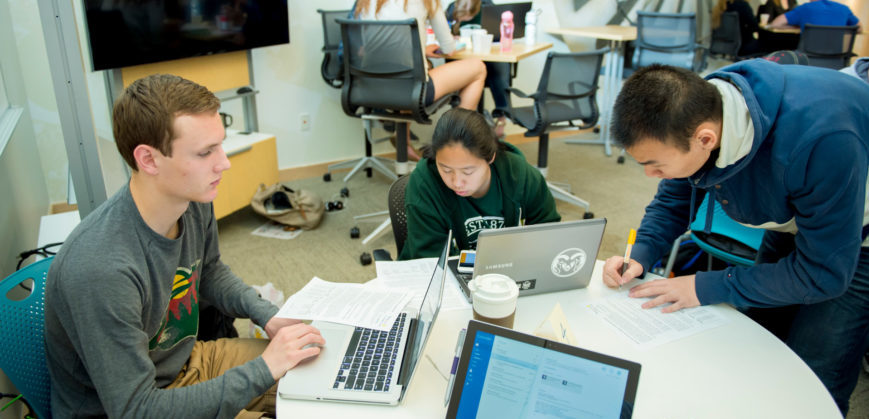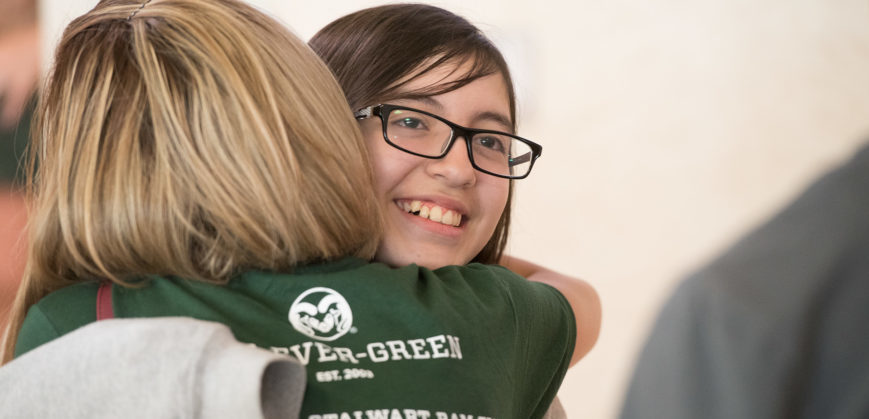
If you ask Colorado State University students, “What is the Student Success Initiative?” you may get some blank looks.
But explain what it is – a collaborative, campus-wide effort aimed at helping undergraduate students find their path, thrive in and out of the classroom, and graduate on a track to success – and you’ll get some nods.
“I didn’t know it was called that, but you can feel it,” says Sarah Hartzell, a senior Human Development and Family Studies major. “It feels like everyone here at CSU is genuinely interested in your success – not just lining up what you have to do, but catering to your experiences and your personal interests.”
Creating a learning environment like the one Hartzell describes requires the time and dedication of countless people – advisors, administrators, mentors, faculty members, registrars, financial aid officers – all committed to seeing CSU students succeed.
Simultaneously, an ever-evolving digital world has profound implications for how students interact with the University, and how it interacts with them.
How can universities like CSU engage with students on a personal level, while embracing technology and everything it can provide?
It takes a village, and it’s called the “high-tech, high-touch approach” – using technology and data to support and inform student achievement, while maintaining human relationships as the central component of student success. It’s a philosophy that CSU has embraced, as the Student Success Initiative officially enters its second decade.
“Technology will never replace a human’s ability to empathize, relate, and support,” says Amy Dinise-Halter, manager of student success projects at CSU. “Yet, a human cannot, for example, possibly gather all the information a student could self-report, if given the opportunity.”
Keeping up in a digital age
Though there’s no substitute for human interaction, there’s no question that technology drives our every day.
The University wants to leverage technology to meet students’ needs – a generation that expects clear, fast, and personalized information. One example: Research completed in 2013 by Experian Marketing Services found that 18- to 24-year-olds sent and received an average of 128 text messages per day – clearly the generational communication channel of choice.
This year, CSU implemented software that allows advisors to more easily text message their students.
RamWeb, the student portal for personal information, course enrollment, grades, and tuition, has also recently been redesigned to be more user friendly. Plans are in place to roll out an even newer version, which will include more targeted and personalized alerts and messaging for students.
You can read more about the success of the Student Success Initiative in the Spring 2017 issue of CSU Magazine, available by mail and online in early June.
Boots on the ground: Academic Success Coordinators
Leaders of the Student Success Initiative have embraced a data-informed mindset, investing money and time into proven predictors of student achievement. Research indicates that quality, personal advising for students leads to better outcomes, so several years ago, CSU started a program called Academic Success Coordinators, or ASCs.
ASCs are there, fundamentally, to help students define a clear path to academic achievement, while also encouraging them to explore what are called high-impact practices outside the classroom – internships, study abroad, service-learning, and more.
Dinise-Halter oversees a network of about 70 ASCs spread across campus. Most are embedded in departments, while some are housed in Undeclared Advising at the Collaborative for Student Achievement. ASCs are charged with providing a “holistic experience” for students that can lead them to success. And in an ongoing partnership with CSU’s Institutional Research division, ASCs have direct access to information that informs how they work with students.
All who wander aren’t lost
Navigating the University can be especially challenging for those freshmen who come in without having selected a major. In fact, about a third of freshmen enroll undeclared, which is consistent with national averages. It’s another juncture at which CSU engages in high-touch practices.
“It’s not just the ‘I don’t know what I want to be when I grow up,’” explains Elliot Cooper, one of 12 Academic Success Coordinators for undeclared students, and whose home base is the Collaborative for Student Achievement. “It’s also the ‘I didn’t meet entrance requirements for one of the competitive majors around campus.'”
Cooper leads Key Explore, one of seven Key Communities – living, learning residential communities at CSU. Key Explore consists of a three-credit fall seminar that emphasize strength finding, and helps students identify their values, interests, skills, and beliefs. A one-credit follow-up in the spring focuses on professional development.

Making a U-turn
Beyond the regular work of academic advising and Academic Success Coordinators, another example of a “high-touch” practice that employs “high-tech” to achieve its objectives is U-Turn, a resource expo organized every year since 2010. The program is overseen by Darrie Burrage, associate director of learning programs at TILT.
Early in the semester, first-years participate in Taking Stock, an early intervention survey that’s administered in close partnership with residence hall advisors. Results are tabulated into low-, medium- and high-risk students, and residence hall advisors meet with students to go over results.
In addition, faculty who teach larger introductory courses participate in Early Performance Feedback, in which students receive an “S” (satisfactory) or “U” (unsatisfactory) assessment early in the semester. Both Taking Stock and Early Performance Feedback help identify students who could benefit from early academic intervention.
These students are recommended to attend U-Turn, a one-stop-shop for all the student resources on campus. That’s everything from TILT tutoring to CSU Health Network, the calculus center to the writing center, internships to career services.
The sum of many parts
The Student Success Initiative is a 10-year-old effort that crosses five university divisions and is composed of countless moving parts.
Even more granular to the efforts are everyday aspects of the undergraduate experience here at CSU that students may not even think about. But they make a difference, in subtle but profound ways: everything from Canvas, a learning management tool implemented in 2015; to the simple ability for students to email their advisors for help when they need it.
Student success, after all, starts with the student.